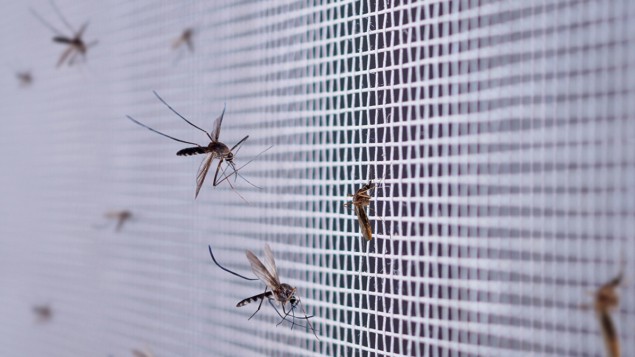AI and infrared spectroscopy identify the age and species of mosquitoes
14 Apr 2022

Researchers in the UK and Africa have developed a quick and cost-effective way to determine the age of malaria mosquitoes using mid-infrared spectroscopy. This is important for assessing the effectiveness of control interventions as only older mosquitoes can transmit the parasite. The scientists say that their approach could also help with other mosquito- and insect-borne diseases.
According to the World Health Organization, there were around 241 million cases of malaria globally in 2020, killing more than 620,000 people. The vast majority of these were in Africa, which was home to 95% of malaria cases and 96% of malaria deaths.
Malaria is transmitted by female Anopheles mosquitoes. Strangely, the average lifespan of these mosquitoes is shorter than the time it takes for the Plasmodium parasites that cause malaria to develop. This means that only a small proportion of mosquitoes live long enough to pass on the disease. Because of this, malaria control interventions such as insecticidal nets tend to target adult mosquito survival. An accurate and reliable method of determining the age of the insects would help assess the impact of such vector controls. The current way to do this involves dissecting mosquitoes’ ovaries. This is expensive, slow and hard to do at scale.
In recent years, there has been some success using infrared spectroscopy to determine the age of mosquitoes. This technique provides information regarding the chemical composition of the insect’s cuticle (its protective exoskeleton), which varies with species and age, based on the light signature returned when it is illuminated with infrared light. But while this approach is accurate for laboratory-reared populations that are genetically similar, spectroscopy has struggled with ageing genetically diverse wild mosquito populations.
Now Francesco Baldini, a medical entomologist at the University of Glasgow, and his colleagues have combined mid-infrared spectroscopy with deep learning to develop a rapid, cost-effective way to identify the species and age of three species of malaria carrying mosquito. They report their results in Nature Communications.
“With this infrared technology, we have developed a tool which could be adopted within current mosquito control plans, has the potential to be scaled up for use across different areas, and would greatly help in testing new products and solutions against diseases transmitted by mosquitoes,” Baldini says.
The researchers used data from more than 40,000 female mosquitoes of different ages from three malaria-transmitting species. The insects came from diverse genetic backgrounds and were reared both in different laboratories and semi-wild conditions in East and West Africa to capture genetic and environmental variations. The artificial intelligence (AI) model was initially trained using mid-infrared spectroscopy data from the genetically varying lab-reared mosquitoes. The team then retrained it using an additional sample of mosquitoes from the semi-wild populations. The resulting model was able to predict the age and species of mosquitoes reared in semi-wild conditions from their mid-infrared signatures with more than 95% accuracy.
To further test the effectiveness of this “transfer-learning” approach, the researchers collected wild mosquitoes in Burkina Faso and Tanzania. They then dissected and age-assessed a sample of these and used them to retrain the AI model that was previously trained on the lab-reared mosquito populations. When tested on more of the wild mosquitoes, this deep-learning mid-infrared spectroscopy system returned similar results to traditional dissection techniques.READ MORE

Baldini says that the technique requires mosquitoes to be collected, killed and then scanned in a laboratory. Mosquitoes are already routinely collected in many areas to check species and malaria infection rates. “The [spectroscopy] procedure takes approximately 10 seconds per mosquito instead of several hours and is essentially free after the upfront cost of the hardware,” he explains.
“We envision this approach could also be applied to other vectors and vector-borne diseases, from filariasis and chikungunya, to sleeping sickness and Zika; and could be used to evaluate the attempts to limit the expansion of invasive mosquito species across Europe and the United States,” says Baldini.
In the future, it may even be possible to scan flying mosquitoes. Baldini notes that this will probably be easier using near-infrared spectroscopy, rather than mid-infrared. “We are working on the development of this type of device,” he adds.
Michael Allen is a science writer based in the UK.
from physicsworld.com 15/4/2022
Δεν υπάρχουν σχόλια:
Δημοσίευση σχολίου